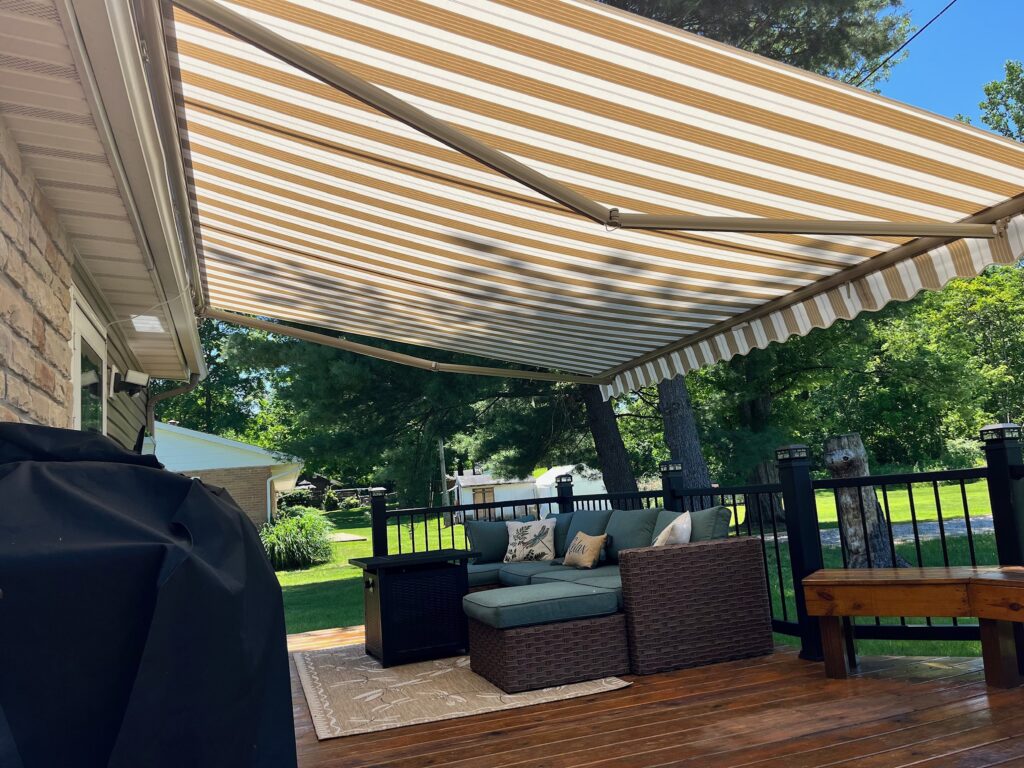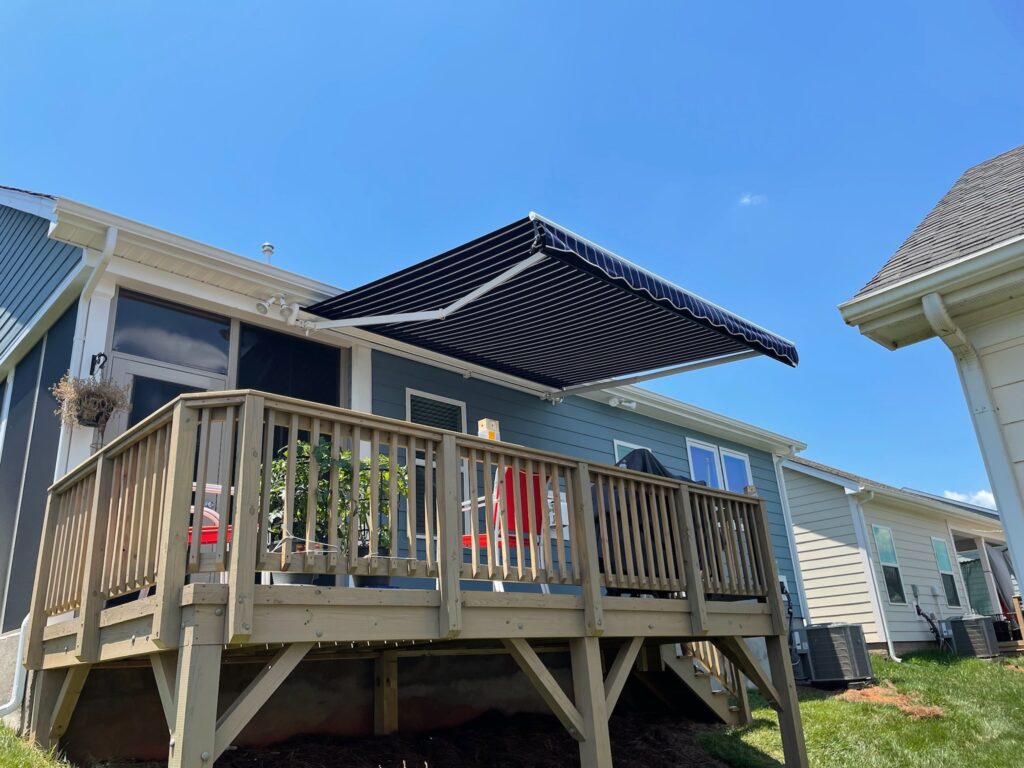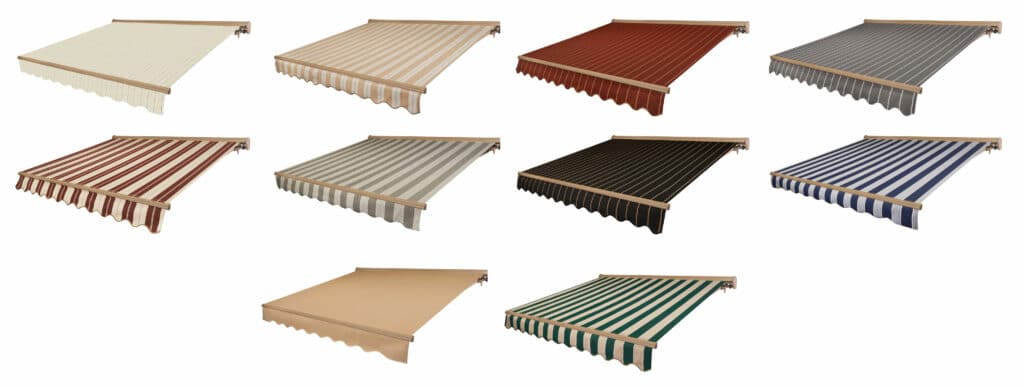Choosing the the right outdoor covering for your home can sometimes feel like stepping from a dark inside room to the bright sun outside – it’s disorienting and hard to figure out where you are. Deciding between a retractable awning vs shade sail isn’t easy when you don’t know much about either.
Both of these outside fabric coverings are useful, but it all hinges on how a homeowner would like their space to function.
Start and End With Your Needs
Though there are lots of options for patio canopies and covering solutions, the heart of the matter is always about your needs. Though things like price, quality, long term functionality, and custom style will clearly factor into whether you choose an awning or a shade sail, it should always come back to the needs of your home and your family.
While attaching one of these to a building isn’t difficult they each have a certain design that lends itself to different needs. Understanding the pros and cons of backyard coverings for different types of homes will help you get exactly what you want with functionality you need.
1 - Basic Structure of Awnings and Shade Sails

The first thing is to get a handle on is the shape and structure of awnings vs shade sails.
A shade sail is made off flexible fabric that’s pulled tight between multiple anchors that are on the roof, a pole, a wall, or another outdoor structure. They can be incorporated into pergolas, porches, and decks. Shade sails can go from any three points, so they can attach all the way down to a deck rail or even the ground, depending on the kind of protection needed.
On the other side, a retractable awning offers protection from a horizontal surface like a door opening, a window, or a wall. Essentially, a retractable awning functions as a roof that can be extended over a space at will. Awnings are necessarily rectangular or square, where shade sails can be triangular.
Shade Sail
- can extend from any anchor points
- horizontal or angular installation
- commonly triangular, but can be any shape
Retractable Awnings
- rectangular or square in shape
- designed to roll in and out at any time
- must be attached to a horizontal surface on the side of a structure
2 - Outdoor Covers Can Be Movable
The most basic kind of sunlight blocking shade solution, a shade sail is simple and straightforward. They can’t be taken down automatically, but they can be manually removed by unhooking the sail from its anchors.
All shapes of shade sails can be taken down once they are installed, though it takes some muscle and tools to unhook them from their anchor points. The anchors themselves can be moved from their existing position to somewhere else, though it’s not a job you can do alone. The flexible nature of the fabric means it’s a two person job at least to either temporarily take down a shade sail, or to move it altogether.
A retractable awning incorporates a motorized gear that rolls the fabric back into the case along a track. When retracted, the awning is designed to blend into the building. A retractable awning that’s designed to roll back into its protective case keeps it from being yanked by winds or weighted down by snow.
Though a retractable awning isn’t permanent, that’s part of the idea of the thing. Unlike a pergola or a gazebo, these canopies are meant to come and go as you wish them too. In the event that outdoor structures are in danger from inclement weather, they can easily be pulled back and blend into the house.
Shade Sail
- must be manually pulled down
- special equipment required to remove from anchors
- movable from one area to another, though not easily
Retractable Awning
- can be automatically pulled in via remote
- permanently attached to the home or structure
- easily retractable

3 - Complexity of Installation
A major difference in sun sails vs. retractable awnings is the installation process. Though technically any kind of project can in theory be a do-it-yourself project, an outdoor cover that’s attached to existing structures does come with some considerations for the DIYer. Though the hardware might be available and the local Home Depot, that doesn’t mean it’s always a great idea to DIY an outdoor structure.
For shade sails, anchor points have to be attached to posts, the side of the home, existing patio structures, etc. The sun protection that theses offer is dependent on their placement, not only at the time of installation, but as the sun moves through the sky. Since shade sails have more of an angular orientation, placement of the anchor points becomes and important consideration.
Professional installers for shade sails will understand how the sun moves and what kind of protection these canopies offer. A quality installer will be able to give you an idea of how much shade and sun protection you’ll get, depending on where the sails are installed.
For a retractable awning, professional installation is important. Since these outside canopies won’t be moved once they’re put on the home, they need to be installed in a solid area to allow them to cover the porch or deck effectively. Marygrove offers easy retractable awning installation all over the United States.
Another consideration is that a retractable awning needs to have the right amount of space from other outside features, like window edges and exterior lighting. Retractable awnings can either be manual or electric. For electric awnings, installation involves the ability to be wired into the building.
Shade Sail
- can be installed DIY
- non-professional installation can be tricky
- shading provided is affected by installation
Retractable Awning
- requires professional installation
- electric retractable awnings need to have power options
- designed to be static
4 - Size is a Factor
Where a retractable awning vs shade sail is placed has everything to do with the size that’s needed.
Shade sails can be large or small. Often, these outdoor coverings are seen on large verandas or terraces, as their more permanent nature makes it more conducive for them to cover wider swaths of space. Another common placement for a shade sail is far from the main structure of the house. Again, this placement lends itself to going with a larger piece of uv resistant fabric.
It’s worth noting that shade sails generally require a significant head space to be effective. This is because the space has to be large enough for the fabric to be pulled taunt.
Retractable awnings are well suited for small spaces, though they are effective on large patios and decks. Tight spaces benefit from the ability to incline a retractable fabric awning up to 90 degrees. Anywhere with a low ceiling clearance works will for a retractable awning.
For smaller spaces, the adjustable nature of a retractable awning is helpful as well. Unlike a more permanent outdoor shade structure, a retractable awning can be rolled out only when needed, preserving the view and the space when it’s not in use. If you need help finding the right size option for you, check out our simple sizing guide.
Shade Sail
- can be large or small
- inability to easily retract confines spaces when not in use
- triangular shape offers an option for odd shaped spaces
Retractable Awnings
- comes in a wide variety of sizes
- retractable nature extends space when not in use
- ability to angle lets provides a good fit for tight spaces
5 - Customization Options
Depending on the company you purchase your retractable awning from, it could be manufactured anywhere. Shade sails are the same – they are manufactured all over the world. There seems to be a list of never ending options for both products.
There are a huge range of customization options for a modern look with both a shade sail and a retractable awning. An example of this is fabric choice – both can be purchased in a wide variety of colors and shades. These style features allow homeowners to design their outdoor space however they’d prefer.
Choosing fabrics is one of the biggest parts of finding the right shade sails or retractable awning. All fabric should be UV protection certified to make sure that it will create not only the look that you want, but the safety that you need.
Shade Sails
- may not fit with a traditional home style
- could require additional posts for anchors
- comes in a wide variety of fabric options
Retractable Awning
- custom awning case will match the home aesthetic
- multiple fabric options
- extend from existing home – no new structure needed

So Which Is Better?
Both shade sails and awnings have different strengths and weaknesses, but what they have in common is that they offer homeowners a measure to make their outdoor space more inviting and usable.
Homeowners who are looking for a cohesive, beautiful way to incorporate more shade into a sunny backyard during the summer should look at both shade sail options and retractable awning options.
Though you might want to have a professional install either one to protect your investment, in the long term you’ll save thanks to the protection from the sun and the extended use of a deck or patio.
The bottom line when choosing between a shade sail and a retractable awning is to find the functionality and look that you want. Creating an outdoor oasis that you value and the fulfilling use of your outdoor spaces are worth it.
